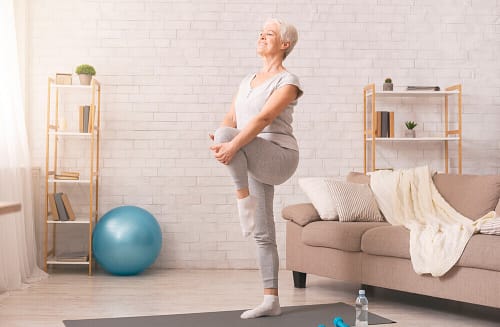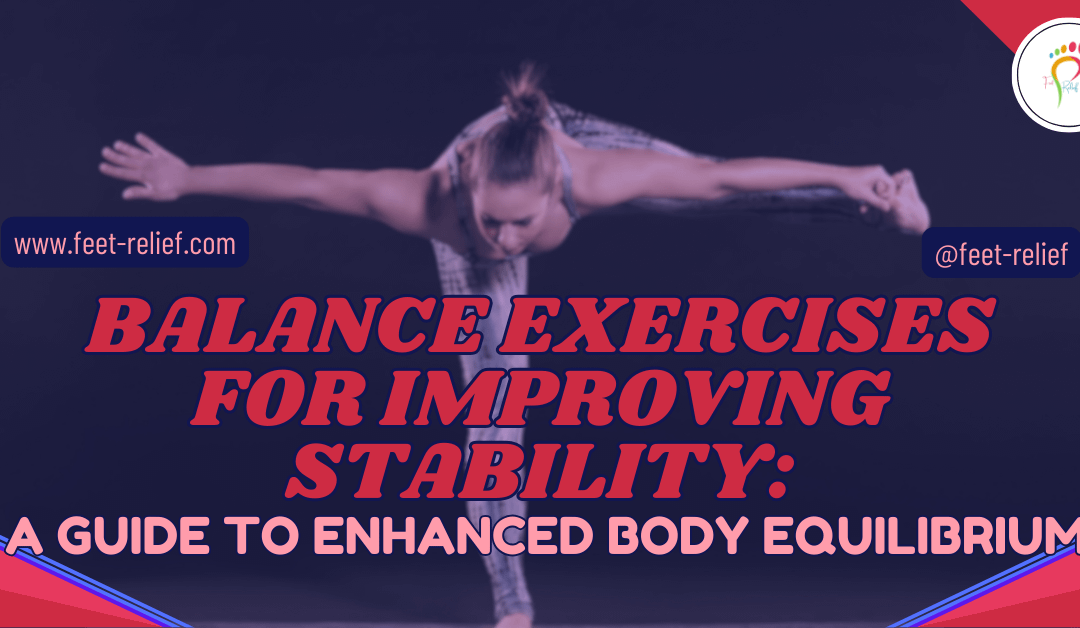Feet-Relief is supported by our audience. When you purchase through one of our links, we may earn a small affiliate commission. As an Amazon Associate I earn from qualifying purchases.Your cost is not affected.
I’ve been working on improving my balance. The idea of a fall as I grow into old age has driven me toward more balance exercises for improving stability and agility as I age.

Balance Exercises For Improving Stability
Balance plays a crucial role in our everyday movements, from walking or reaching for something to dancing or playing sports. It’s like an invisible hand helping keep everything in check. Imagine going through a day without accidentally bumping into things. That’s balance working its magic.
Stability has your back when it comes to health. Think of it as your body’s steadfast friend, ensuring your movements are smooth and reducing the odds of injuries. Holding your head high without wobbling or standing your ground against a sudden push are gifts of good stability.
Surprisingly, many folks think balance exercises are just for gymnasts or seniors. Not true at all! These exercises are versatile and can benefit everyone, regardless of age. They’re not just about standing on one leg, though. Balance training is more about overall control, which is priceless in keeping us steady both physically and mentally.
The Benefits of Improving Stability
Enhancing balance is like unlocking a new level of agility and coordination in your body. Imagine weaving through obstacles with ease, just by honing your stability skills. It’s about more than just physical steadiness—think of it as upgrading your entire movement system.
Keeping falls and injuries at bay is a big win! By working on your stability, you create a bit of a safety net for yourself. Whether you’re walking on uneven ground or just bustling around the house, strong balance skills mean fewer chance encounters with the floor.
Athletes, this one’s for you! Amping up your balance regime can give your performance a serious boost. It’s the secret sauce for better control during rapid movements or when bouncing back from an injury. It pretty much turbocharges your training sessions.
Confidence comes in when you’re moving through your day without feeling like you might trip. There’s a boost in assurance knowing you can handle what life literally throws at you. It makes getting through busy, activity-packed days a whole lot easier.
The Science Behind Balance: Key Muscles and Systems
At the core of great balance is, well, your core. The muscles around your abdomen and pelvis keep your body upright and steady. Strong core muscles mean you’ll sway less when you hit bumps in the road, literally and figuratively.
The vestibular system acts like your body’s internal compass. Located in your inner ear, it tells your brain about motion, head position, and spatial orientation. Without it, even a simple turn of the head could lead to dizziness, throwing off your entire balance.
Proprioception feels a bit like magic—it’s your body’s ability to sense where it is in space without consciously thinking about it. This innate sense helps you recover when you trip or even when you’re just moving through a crowded space.
The neat thing about neuromuscular connections is that they can improve with conditioning. Regular balance exercises strengthen these brain-body links, making your movements more precise. You can train your body to react quicker and adapt better in dynamic environments.
Top Balance Exercises for Beginners
Starting with balance exercises can be both fun and rewarding, and you don’t need any fancy gear. Simple routines like standing on one leg or walking heel-to-toe in a straight line are excellent starters. These exercises gently engage your body’s support systems without overwhelming them.
Safety first, always. Make sure to have a stable support nearby, like a wall or chair, especially when trying these exercises for the first time. Avoid surfaces that are too slick or uneven to minimize the risk of slipping.
Age is just a number when it comes to balance training. Young or old, anyone can adapt these exercises to fit their comfort and capability level. Some might find standing stretches enough, while others might be ready to hold poses a bit longer.
Staying consistent in your practice helps your body learn and maintain these new skills. Even just a few minutes a day can make a noticeable difference over time, turning simple exercises into great boosters for your stability and confidence.
Advanced Stability Workouts for Enhanced Performance
For those who are ready to push their limits a bit, advanced stability workouts offer that extra challenge. Incorporating single-leg squats or dynamic movements like jump lunges can significantly up the ante. This level of engagement can really target those deep stabilizer muscles.
Adding balance equipment into your workouts is a game-changer. Tools like balance boards and stability balls introduce an element of unpredictability, forcing your body to adapt and learn faster. These tools make your workouts not only more effective but also more interesting.
For fitness enthusiasts, blending balance exercises with your routine can improve performance across the board. Whether it’s yoga, Pilates, or strength training, enhancing stability can elevate the results you get from other forms of exercise.
It’s crucial to listen to your body and progress at your own pace. Just because a workout is advanced doesn’t mean you have to rush into every move. Pay attention to your form and prioritize it over the number of reps or duration of exercises.
Incorporating Balance Training into Your Daily Routine
Including balance exercises in your daily schedule doesn’t have to feel like a chore. You can do them pretty much anywhere, whether you’re brushing your teeth or waiting for your coffee to brew. It’s all about weaving them into your usual activities.
Adapting workouts to fit your personal needs is key. If you find certain movements too easy or too challenging, tweak them to suit your fitness level. It’s your routine, and making it work for you ensures long-term success.
Mixing in elements of balance training with other exercise forms maximizes benefits. A quick balancing act before your morning jog or post-gym cooldown keeps things rounded and interesting. Variety is not just a spice of life but also the secret to holistic fitness.
For the time-strapped, dedicating efficient chunks of a few minutes a day can lead to noticeable improvements. Balance exercises are quick hitters—you won’t need to reserve large blocks of time to reap their benefits. Just slip them in during breaks or downtime.
As you grow more comfortable, take the exercises out for a spin in different settings. Try them on different surfaces or in varied environments to keep your body guessing and adapting. It’s not just about building skills but also shaking things up to make it fun.
Conclusion: Embracing Balance for a Healthier Life
As you integrate balance exercises into your day-to-day, you’ll likely notice an uplifting shift—not just physically but mentally too. It’s a journey towards feeling more at ease in your own movements and building a bit of resilience along the way.
Keeping up with regular training translates into long-term gains. You might find daily activities become smoother, sudden movements don’t throw you off, and perhaps you even discover a new hobby or sport you wouldn’t have tried before.
Cultivating this skill brings more than just physical rewards. There’s a subtle boost in self-assurance when you know your body can handle surprises with agility and grace, which often spills over into other life areas.
Remember, balance is an ongoing practice. Staying consistent and mixing things up will help keep you engaged and continuously progressing. Your healthier, more stable self is within reach—one balanced step at a time.
Amazon and the Amazon logo are trademarks of Amazon.com, Inc, or its affiliates.











